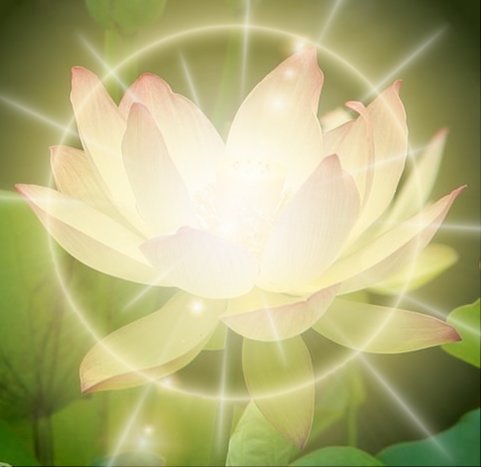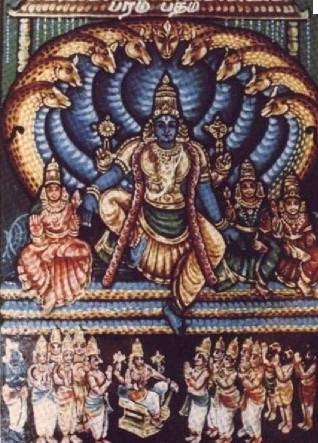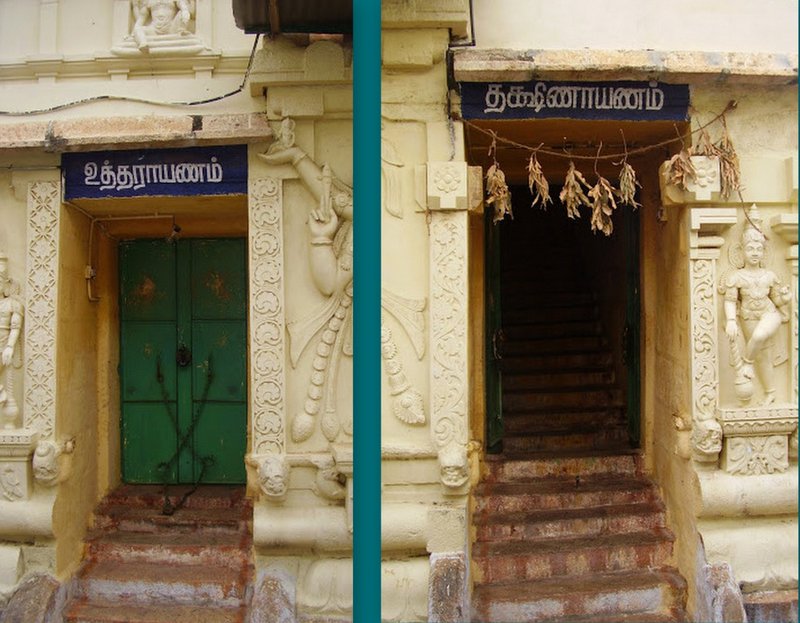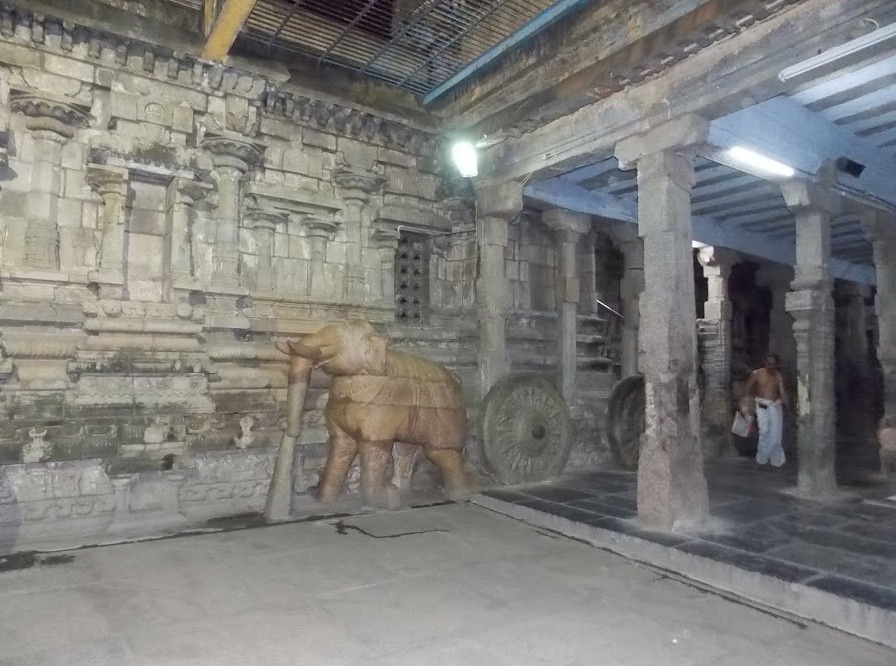Today, July 16th 2013, marks the beginning for DakshinAyana period. There are two entrances to the shrine of Aravamudhan at Thirukudanthai (Kumbakkonam). The southern entrance, “The dakshiNAyana vAsal” is used during dakshiNAyanam (about the middle of July to middle of January) and the northern entrance, “The uttarAyaNa vAsal” is used during uttarAyaNam (about middle of January to middle of July). The two entrances have nine steps each which is symbolic of the nine steps to moksham. Similarly, there are also two entrances dakshiNAyana vAsal and uttarAyaNa vAsal at Thiuvellarai divya desam as well. In another abhimana sthalam, viz., Sri Chakrapani Temple, Kumbakonam, there are two entrances which are opened during the respective dakshinayana period (southern entrance) and uttarayana period (northern entrance).
Here is a writeup about the nine steps:
From the time a bound soul wishes to end the cycle of births and deaths until it attains liberation, Svami Desika has listed nine steps that it takes in its onward path.
viveka nirveda virakti bheetayah
prasaadahetu utkramana archiraadyah,
prakrityatikraantapada adhirohanam
praaptih iti atra tu bharvanaam kramah.
There is one action that every one should take in order to really reap the benefit of a human birth. It is to introspect on the purpose of life in a peaceful atmosphere.Surely,all of us would have, at some time or the other, indulged in some form of introspection or reflection, upon some aspect of our life. But it would have been on our needs and desires, our aspirations on how to get out of current problems. After several such efforts, we still remain dissatisfied and generally unhappy. Or we may get peace or happiness, which lasts only for a short while, may be for a few days or weeks. This is because all the material objects such as wealth, fame, power, the sensory pleasures that we seek and, in fact, the material comforts that we enjoy, are not permanent. The happiness we get out of acquisitions is as short-lived as a bubble on water and fleeting like the flash of lightning. Moreover, such possessions bring with them the burden of fear, stress and untold agony, especially when we lose them. Such is our attachment towards these material goods. This cycle goes on and on. Surely this is not the purpose of our lives. There is something more to being born in the world, other than being caught in this vicious cycle. So we realise that, in order to get out of this rut, we must ensure that we are not reborn in this world. Then the wisdom would dawn upon us to make this life of ours the last of our lives in this world. This then should become the objective of all human beings in the world. Sri Tondaradippodi Azhvar has said, “Thus I do not want birth (Tirumaahi3). Many Azhvars have echoed similar sentiments. It is also clear from the scriptures that the supreme Lord has given the soul a human body only to contemplate and redeem itself from the cycle of births and deaths.
Now, there is a sure way to do away with any further births. Svami Desika,the lion among poets and philosophers, has outlined the steps in his Paramapada-sopanam,which would enable us to avoid future births.
By following the guidance of Sri Desika, we can get out of the miseries of worldly lives and attain eternal bliss. There is no end to the bliss of being united with the supreme Lord at Srivaikuntha and enjoying the company of the ever-free and liberated souls there. All of us rightfully belong to the supreme Abode; that is our permanent residence. All the worlds below that, including Brahma’s sphere, are like rented houses. Just as living in a rented place is beset by problems while living in our own home brings comfort and happiness, so too will residing at Srivaikuntha give us everlasting bliss. Srivaikuntha, the Lord’s Abode, also known as Paramapada, is outside of the universe and is situated above all other worlds. Being at Paramapada, we will perceive and experience the supreme Lord directly. In order to reach this place, Svami Desika has built just nine easy steps for us to climb up. Let us briefly study the steps he has outlined in this work and try to follow them so that we achieve the goal of not being born again in the world.
The nine steps are: (i) discrimination (viveka), (ii) despair (nirveda), (iii) detachment (virakti), (iv) dread (bheeti], (v) purification (prasadahetu), (vi) ascent (utkramana), (vii) the bright path (archiradi), (viii) reaching the divine world (suddhasattva-praapti) i.e. crossing the material universe and finally (ix) attaining His lotus Feet (Praapti). By climbing the nine steps, we will reach Srivaikuntha and never return to this world. It is not enough to merely know the names of the nine steps; one should know the meaning and significance of each of them. So let us learn about them in brief.
 I. Viveka: The first step is called ‘viveka’. In order for a person to attain salvation, he should have the ability to think and reason or to discriminate between the real and the false. He should understand the real meaning of the term ‘I’ which is used to denote oneself. He should realise that ‘I’ refers to the soul inside the body. It is eternal and atomic in nature; it is full of knowledge and awareness and belongs to God. It has taken several births and is born as a human being. This is the first part of our awareness.
I. Viveka: The first step is called ‘viveka’. In order for a person to attain salvation, he should have the ability to think and reason or to discriminate between the real and the false. He should understand the real meaning of the term ‘I’ which is used to denote oneself. He should realise that ‘I’ refers to the soul inside the body. It is eternal and atomic in nature; it is full of knowledge and awareness and belongs to God. It has taken several births and is born as a human being. This is the first part of our awareness.
The second truth to be realised is that the Supreme and the omnipresent Lord is Father and Mother of the whole universe. He is also an Embodiment of mercy. Along with Goddess Lakshmi, He bestows upon us the fruits of our actions viz. pleasures and punishments for our good or bad deeds. Dwelling in the divine Srivaikuntha, along with Goddesses Sridevi, Bhudevi and Niladevi, He dispenses joy to all the souls there. Thirdly, in order to attain liberation at the end of this birth itself,we should seek a preceptor and follow his teachings, just as our forefathers did. This is our third logical conclusion. One who has realised these three truths would have climbed the first step.
2. Nirveda: This is the second step towards liberation. The term ‘nirveda’ means regret bordering on despair. We have realised that all of us belong to Sriman Narayana and are His children. He is ever ready to grant liberation and bestow upon us the same bliss enjoyed by Him. This being so, we have, until now, frittered several thousands of years by taking innumerable births in this world. Alas, in our folly and ignorance, we have not done even a single good deed which might merit us a place next to Him; we have not cared to associate ourselves with noble scholars and good elders. Not only have we committed so many sins, but we have also failed to perform the proper rituals prescribed in the scriptures.
Due to the many transgressions committed by us, we have undergone so much suffering; by our devious and petty behaviour, we have wasted so many lives and indulged in atheistic arguments at times. Disrespectful of scriptures,we have behaved willfully at times. We are now overwhelmed with repentance and start thinking, ‘Had I only learnt to worship the Lord earlier itself, I would have redeemed myself sooner and not lost so much precious time! So now at least, will this soul reach Him? At whose Feet shall I seek refuge to attain liberation? Which great learned scholar would be kind enough to help me seek redemption?’ When a person is remorseful and despairs of himself in such a vein, he would have climbed this second step.
3. Virakti:This is the third step. The term ‘virakti’ means detachment i.e., detachment from all petty and worldly pleasures and seeking the highest !goal of being united with God. By recollecting about all the travails of Brahma and all the other celestials and the sufferings undergone by the mighty rulers of all the worlds, we will get rid of the desire to live here. The fear and tension that Power and position bring with them, the disappointments we feel when our wants are not fulfilled only go to show that these pleasures are fleeting-When we See how even powerful and affluent men are unable to enjoy their own wealth, when even in loving frequent squabbles appear and disease and sickness stalk the earth, any sane thinking man will lose all his desire for pleasures. He conclude that these are but transitory. When he has destroyed his mundane and material desires, he would have climbed the third step
4. Bheeti: This fourth step implies fear. If we have climbed this step, the rest becomes easy. This is the last of the difficult steps. Let us find out what we have to fear. Now, we have been born as human beings with superior intellect. But we have passed through innumerable births as insects, reptiles and animals such as donkey, dog, bear, lion and monkey and have gone through many difficulties. Due to some good deed or action in our earlier births, we are born as humans. This might well be the last but one noble birth among all creations. Therefore, the thought that we will be reborn in this world in any form should only instil fear in us, because any future birth is a corollary of sins and misdeeds. Man has been continuously committing one transgression after another, while his account of good deeds more or less is empty. So, it is quite probable that we will be born only as lesser creatures like animals or insects in keeping with the balance of bad deeds. Even if we are born again as humans, we will be gripped by hunger, famine, old age and other Untold miseries.When a wise thus, he will start to fear further births and will have climbed the fourth step towards liberation
 5. Prasaadahetu fifth step is called ‘prasaadahetu’. Due to the countless number of misdeeds committed in our previous births, we have incurred the wrath of the Lord Who is both the Father and Mother to all. The only way by which we can make Him forget this anger and shower His Grace on us is by surrendering ourselves to Him. Without atoning thus, we will not be able to proceed further. This fifth step of surrender has been dealt with in detail in Svami Desika’s Srimad Rahasyatrayasara, with the support of several authoritative texts. Let us briefly learn about this step. We do not have the capacity to perform the arduous bhakti-yoga like the sages.
5. Prasaadahetu fifth step is called ‘prasaadahetu’. Due to the countless number of misdeeds committed in our previous births, we have incurred the wrath of the Lord Who is both the Father and Mother to all. The only way by which we can make Him forget this anger and shower His Grace on us is by surrendering ourselves to Him. Without atoning thus, we will not be able to proceed further. This fifth step of surrender has been dealt with in detail in Svami Desika’s Srimad Rahasyatrayasara, with the support of several authoritative texts. Let us briefly learn about this step. We do not have the capacity to perform the arduous bhakti-yoga like the sages.
Therefore, in accordance with Lord Krishna’s declaration in the Bhagavad Gita, where He assures us of liberation when we take refuge at His Feet, we should perform surrender to Him and make a vow that, hereafter, we will do only those acts that will please Him and desist from committing any transgression. While doing so,we should make a fervent prayer to Him asking for His pardon with the plea that, even though we have been the worst of sinners, we have now grasped His Feet and so we believe that He will forgive even the gravest offences committed by us. We are now truly repentant and surrendering to Him.
We have now understood that the soul and this body belong to Him and that He is our only refuge. We now realise our inability to perform any other means to attain Him (such as bhakti-yoga). When we pray to Him seeking not to be reborn in the world, we state our realisation that our goal is to serve Him and Him only and enjoy such unending service to Him. Further, it has to be understood that the act of surrender itself is through His will only. He is the means to liberation and the object of our prayers. By offering the act itself and its fruits to Him and by the chanting of the dvaya mantra, we would have climbed the fifth step. This is the central and most important step in the whole process and requires the guidance of an acharya or gum. The person who has so surrendered has become a prapanna.
 6. Utkramana: This is the sixth step and it refers to the departure of the soul of the prapanna from his body at the end of his life. Though this is a natural occurrence and is common to all souls, there is a difference between the departure of the soul of a prapanna and those of others. During a person’s last moments, when the soul is ready to depart, all the sense organs are first withdrawn into the mind, which then merges with the vital air. The subtle forms of the five elements,which constitute the body and the prana, along with the soul, are taken in hand by the Indwelling Form (the Antaryami) of the supreme Being. Upto this point, the process is the same for all souls i.e. those who have not surrendered and those who have. In the case of the former, the supreme Being casts away the souls in the various other passages which lead to further births in the world. In the case of the prapannas, the Lord propels the soul through the 101st passage (sushumna naadi) into another direction, which process ensures that the soul is not reborn. This experience is itself a very pleasant one for the soul. A person would have ascended the sixth step when this takes place.
6. Utkramana: This is the sixth step and it refers to the departure of the soul of the prapanna from his body at the end of his life. Though this is a natural occurrence and is common to all souls, there is a difference between the departure of the soul of a prapanna and those of others. During a person’s last moments, when the soul is ready to depart, all the sense organs are first withdrawn into the mind, which then merges with the vital air. The subtle forms of the five elements,which constitute the body and the prana, along with the soul, are taken in hand by the Indwelling Form (the Antaryami) of the supreme Being. Upto this point, the process is the same for all souls i.e. those who have not surrendered and those who have. In the case of the former, the supreme Being casts away the souls in the various other passages which lead to further births in the world. In the case of the prapannas, the Lord propels the soul through the 101st passage (sushumna naadi) into another direction, which process ensures that the soul is not reborn. This experience is itself a very pleasant one for the soul. A person would have ascended the sixth step when this takes place.

7. Archidi: This is the seventh step. The archirdi maarga is the path that a redeemed soul takes on its way to salvation. Throughout this journey, the soul is guided by the Lord Himself, passing through the various realms of His celestial servants such as the gods of Agni, of Light, the gods of the directions, the Moon god, Varuna, Vidyut Purusha, Indra, Brahma, etc. These divine servants of the Lord treat the soul with great regard and pleasure and entertain him royally. The celestial being Vidyut Purusha, also known as ‘Amaanava’, takes him through the cosmic path with a view to entrust him to the supreme Being in the Para Form in Srivaikuntha. These guiding celestials are called ‘Aativaahikas’. This step is the seventh of the nine steps outlined by Svami Desika.
8. Suddasattva-aadesa-praapti: In this eighth step, the soul reaches the outside of the primordial realm called prakriti mandala, which is outside the material universe. The Viraja river separates this material universe from the transcendental plane, Srivaikuntha,where Sriman Narayana rests in all His glory Srivaikuntha or Paramapada or nityavibhuti, as it is variously called, is made up of purest positive matter (suddhasattvasvarupa). The journey through this phase is called ‘padaadhirohana’, with Vidyut Purusha escorting the soul beyond the cosmic path and across the Viraja river. Here, in the river, the soul sheds its subtle form and, by sheer will alone, crosses the river. (It should be noted here that in Srivaikuntha, all actions are achieved by mere will alone
The soul then assumes an auspicious, radiant form. Then, the divine beauties in the Srivaikuntha bedeck him in befitting ornaments. Amidst the playing of several musical instruments, he is taken past thousands of forts and towers. Enroute, he is entertained by other souls who are already there in the service of the Lord. To the accompaniments of joyful and welcoming songs and music, he beholds the sight of the supreme Being and is ushered into His presence. The soul has now climbed the eighth and penultimate step, in the flight of nine steps, to everlasting happiness.
 9. Praapti: This is the ninth and the last of the steps indicated by Svami Desika, where a realised soul makes his last ascent.The Aativaahika known as Amaanava, now entrusts the soul to the supreme Lord. The Lord, seated on Adisesha His serpent-bed, along with His three Consorts, Sridevi, Bhudevi and Neeladevi, welcomes the liberated soul, embraces him with great joy and bestows upon him a glowing form and the same capacity as His to perceive and enjoy everything. By His sheer benevolence, He now enables the jivatma to enjoy all the privileges that He has access to. The soul is now in a state of supreme bliss. This is the state and the essence of being in ‘Praapti’, the ninth step.
9. Praapti: This is the ninth and the last of the steps indicated by Svami Desika, where a realised soul makes his last ascent.The Aativaahika known as Amaanava, now entrusts the soul to the supreme Lord. The Lord, seated on Adisesha His serpent-bed, along with His three Consorts, Sridevi, Bhudevi and Neeladevi, welcomes the liberated soul, embraces him with great joy and bestows upon him a glowing form and the same capacity as His to perceive and enjoy everything. By His sheer benevolence, He now enables the jivatma to enjoy all the privileges that He has access to. The soul is now in a state of supreme bliss. This is the state and the essence of being in ‘Praapti’, the ninth step.
when a Person has gained this knowledge, he would have achieved the purpose of life. He will make earnest attempts to reach his rightful and eternal abode at the earliest.
Conclusion
Thus, Svami Desika has constructed this edifice of nine steps, in order to assist all the drifting souls and guide them properly. Blessed are the wise who have known this, acquired more knowledge and have attained liberation. A person who is unable to pass through these steps should at least strive to know about the fifth step, i.e., surrender (saranagathi). This is the central step around which all the others are constructed. He should then follow it with total conviction, and meditate on the other steps through which so many great scholars and sages have climbed before him, and which is accessible to people of all sects. All the souls in this universe are rightfully entitled to be in the service of the Lord, Sriman Narayana. Let us not be misguided by the so-called charms and wealth of this material world. With the help of scholars and able teachers, let us learn about these nine steps and attain the fruits of eternal bliss by ensuring that this is our last birth on earth and by reaching the supreme Abode.
This article is extracted from Nrushimapriya, Written by – Shalini Narayanan, Based on an article by His Holiness Srimad Mukkur Azhagiyasingar, the 44th Pontiff of Sri Ahobila Mutt












